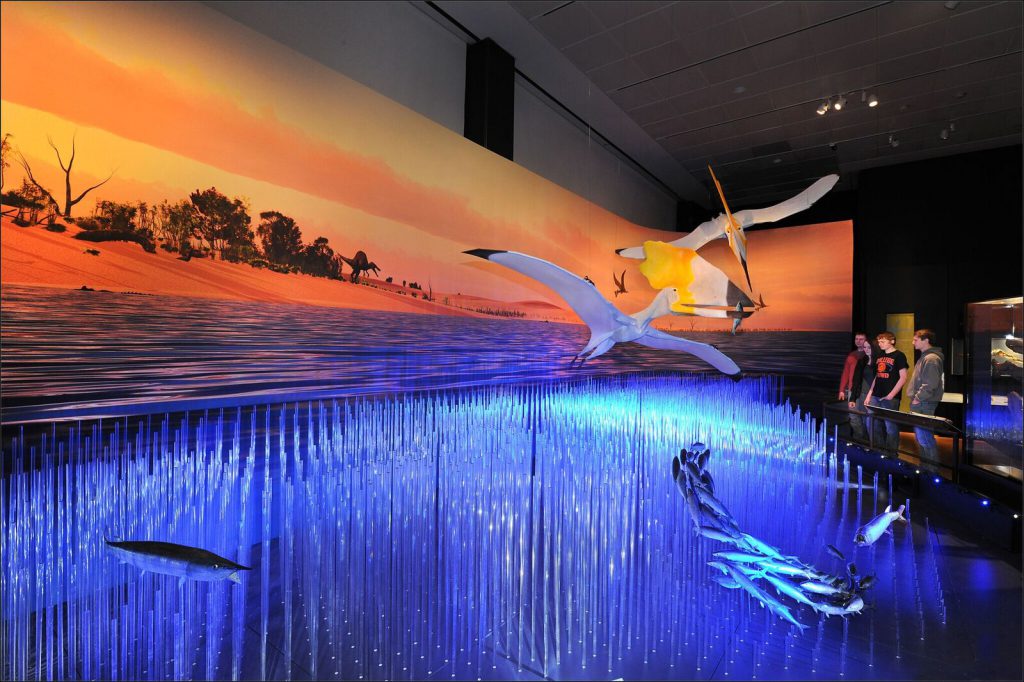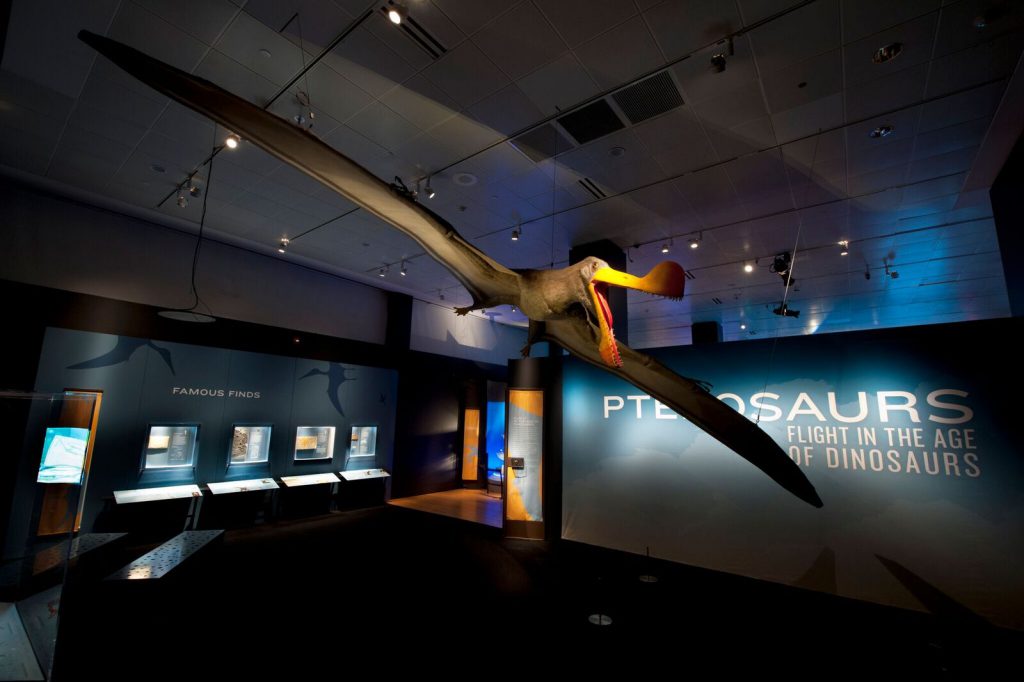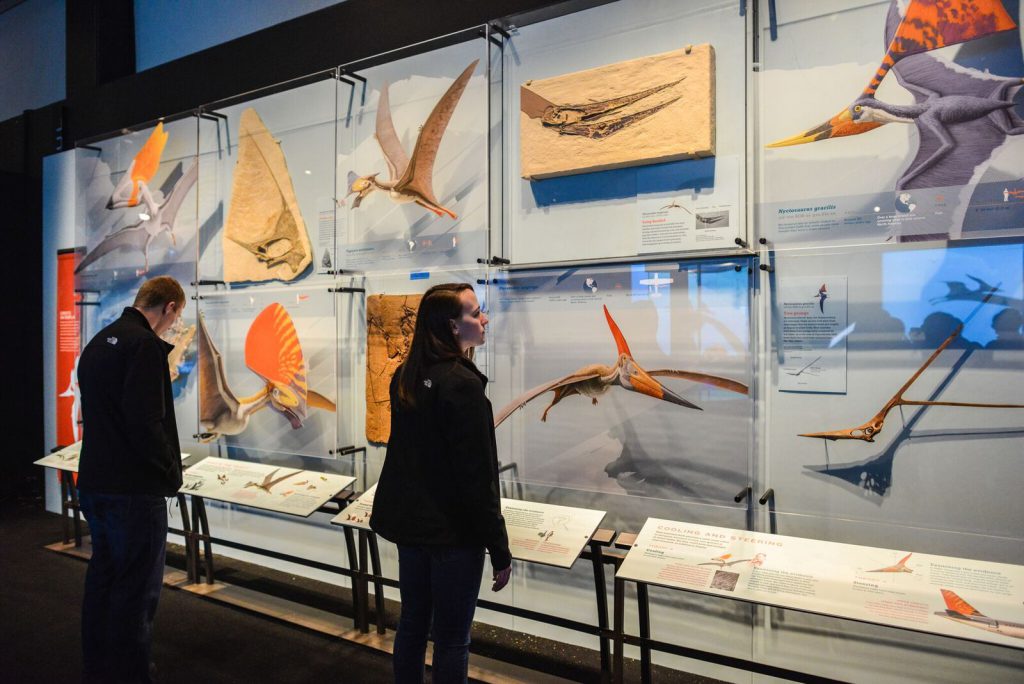 A new exhibit, Pterosaurs: Flight in the Age of Dinosaurs, opened this week at the Natural History Museum featuring flying reptiles that will entice even the most reluctant museum goer. Originating at the American Museum in New York this impressive exhibit is in LA from July 3-October 2 and is the largest exhibit of Pterosaurs ever staged. The exhibit is large and colorful and showcases some Pterosaurs that are unique to NHM.
A new exhibit, Pterosaurs: Flight in the Age of Dinosaurs, opened this week at the Natural History Museum featuring flying reptiles that will entice even the most reluctant museum goer. Originating at the American Museum in New York this impressive exhibit is in LA from July 3-October 2 and is the largest exhibit of Pterosaurs ever staged. The exhibit is large and colorful and showcases some Pterosaurs that are unique to NHM.
Technically not classified as dinosaurs, Pterosaurs are the winged reptiles of the dinosaur age that fascinate paleontologists, scientists, flight enthusiasts and will surely capture the imaginations of dinosaur kids. Pterosaurs are the first back-boned animals to evolve powered flight and they range from the size of a sparrow to that of a two-seater plane. Young kids will recognize the Pteranodon from one of the charming leads on the PBS show Dinosaur Train. Click here to see some nice interactive videos about these odd creatures which, in the words of this reporter, are “not quite bats and not quite birds”.

The NHM is hosting several family days designed to create a full experience for kids and parents alike. As Curator Nate Smith says. ‘We are trying to capture everyone.” The goal of the exhibit is to have science meet audience experience. So in keeping with NHM mission there are lots of interactive exhibits, short films and plenty of objects to touch and explore. Several interactive exhibits help visitors see the world from a pterosaur’s-eye view. The most fun one is ‘Fly Like a Pterosaur” You stand on marks and use your body to “pilot” the Pterosaur on the screen in front of you over an interactive, prehistoric landscape. The goal is to fly well enough to capture bugs or fish. Capturing the prey isn’t easy, but you do get the sense of how your body can make the Pterosaur take off, soar and dive and crash, which is fun for kids and their parents. For a different perspective on flight, you can also experiment with the principles of pterosaur aerodynamics in an interactive virtual wind tunnel that responds to the movements of their hands.

Add to this five iPad stations that offer inside scoops on different Pterosaur species Pteranodon, Tupuxuara, Pterodaustro, Jeholopterus, and Dimorphodon—with animations of pterosaurs flying, walking, eating, and displaying crests; multi-layered interactives that allow users to explore pterosaur fossils, behavior, and anatomy; and video clips featuring commentary from curators and other experts.
 Also on display are fossils, as well as, large scale models of the Pterosaurs and their habitats. The largest and most impressive is the Quetzalcoatlus, which has a wingspan of 33 feet. For paleontologists, pterosaurs present a special challenge: their thin and fragile bones preserve poorly, rendering pterosaur fossils rarer than those of dinosaurs and other prehistoric animals. Several exhibits break down the fossilization process to show how the composition of pterosaur bones affects their potential for preservation. The exhibits engage kids by showing the relationship of these prehistoric winged creatures to modern day bats and birds.
Also on display are fossils, as well as, large scale models of the Pterosaurs and their habitats. The largest and most impressive is the Quetzalcoatlus, which has a wingspan of 33 feet. For paleontologists, pterosaurs present a special challenge: their thin and fragile bones preserve poorly, rendering pterosaur fossils rarer than those of dinosaurs and other prehistoric animals. Several exhibits break down the fossilization process to show how the composition of pterosaur bones affects their potential for preservation. The exhibits engage kids by showing the relationship of these prehistoric winged creatures to modern day bats and birds.
FAMILY DAYS:
The family days are Saturday July 16 and Sunday August 14 from 10:00 am to 3:00 pm. These days offer more programming for families and a chance to meet and talk with the curators of this exhibit. They have also added a gift shop that is dinosaur-centric for familes who are on the hunt for new dinosaur books, games and puzzles.
Natural History Museum of Los Angeles County // 900 Exposition Blvd., Los Angeles, CA 90007
The exhibit is $12 plus the price of admission. Tickets to the exhibition are free for NHM members. Click here to become a member.
Written by Cary Bickley

